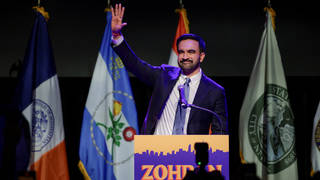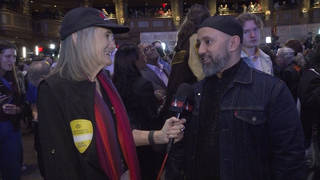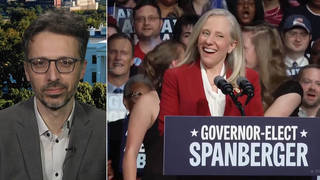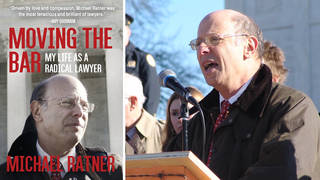
Guests
- Pardiss Kebriaeisenior staff attorney with Center for Constitutional Rights. She has represented Abdul Nasser Khantumani and his son, Muhammed, since 2008. Her article for Harper’s is “Life After Guantánamo: A Father and Son’s Story.”
We look at the extraordinary story from Guantánamo of a father and son who were held for many years and what became of them after their release. Abdul Nasser Khantumani and his son Muhammed were imprisoned in Guantánamo in 2002. Muhammed was still a teenager when he was taken into U.S. custody in 2001. He was released in 2009 and resettled in Portugal. His father was resettled in Cape Verde almost exactly a year later. They have not been able to meet each other since. A new article in Harper’s Magazine details their ordeal, including how their relationship was used against them in Guantánamo: “Interrogators learned early on that proximity to Abdul Nasser was a 'comfort item' they could manipulate to try to make Muhammed talk. After Muhammed became uncooperative, they relocated him as a form of punishment. It would be years before they would hear each other’s voices again.” We are joined by Pardiss Kebriaei, a senior staff attorney with the Center for Constitutional Rights who has represented Abdul Nasser Khantumani and his son Muhammed since 2008. Her article for Harper’s is “Life After Guantánamo: A Father and Son’s Story.”
Transcript
JUAN GONZÁLEZ: We end today’s show with an extraordinary story from Guantánamo of a father and his son who were held for many years and what became of them after their release from the detention facility. Abdul Nasser Khantumani and his son Muhammed were imprisoned in Guantánamo in 2002. Muhammed was still a teenager when he was taken into U.S. custody in 2001. He was released in 2009 and resettled in Portugal. His father was resettled, however, in Cape Verde, almost exactly a year later. They have not been able to meet each other since.
AMY GOODMAN: A new piece in Harper’s Magazine details their ordeal, including how their relationship was used against them at Guantánamo: “Interrogators learned early on that proximity to Abdul Nasser was a 'comfort item' they could manipulate to try to make Muhammed talk. After Muhammed became uncooperative, they relocated him as a form of punishment. It would be years before they would hear each other’s voices again,” unquote.
We’re joined now by the author, Pardiss Kebriaei. She is senior staff attorney for Center for Constitutional Rights and represented the Khantumanis, both Abdul Nasser and his son Muhammed, since 2008. The piece headlined “Life After Guantánamo: A Father and Son’s Story.”
Welcome back to Democracy Now!
PARDISS KEBRIAEI: Thank you, Amy.
AMY GOODMAN: So, tell us their story.
PARDISS KEBRIAEI: You know, father and son, Muhammed and Abdul Nasser, the circumstances of their capture were actually not unlike hundreds of other prisoners. They were in Afghanistan with a large number of their family. They fled when they heard the U.S. was going to attack. They were crossing the border into Pakistan and seized in Pakistan, presumably turned over to the United States for bounty. We know that that was a widespread practice at the time. They were transferred through the network of prisons we know existed, in Pakistan and Kandahar in Afghanistan and then back to—and then, ultimately, to Guantánamo. In Guantánamo, they suffered a brutal torture that we have heard a lot about, that’s been documented. Muhammed was held in continuous solitary confinement for three years. But—
AMY GOODMAN: How old was he when he was taken?
PARDISS KEBRIAEI: He was a teenager. He says 17, 17 or 18, had a year of high school left, like you said. But, right, I mean, one of the most devastating aspects of his torture was the separation with his father. They were at a certain point held together, but sort of brought close and then moved apart as a way of pressuring Muhammed, punishing him when he didn’t speak. And it was devastating to him. Ultimately—
JUAN GONZÁLEZ: And he was hooded for two months, at one point?
PARDISS KEBRIAEI: He was hooded—you know, like all prisoners, hooded in transit from Pakistan to Kandahar, to Camp X-Ray in Guantánamo. You know, ironically or not ironically, but on his way out of Guantánamo, hooded just the way he came in. I mean, that’s the experience of many other prisoners. But, you know, the sort of continuing pain of their story is their continuing separation. They were cleared for release by the Obama administration in 2009, like over 120 other men.
AMY GOODMAN: They were never charged.
PARDISS KEBRIAEI: They were never charged, like most of people who have been held at Guantánamo, never charged, cleared—filed habeas cases. Those cases were stayed. The government sought a stay in those cases. The court agreed, because they were ultimately cleared for release. And in 2009, Portugal came forward—there was a lot of goodwill at the time—offered to take Muhammed, but not his father. So there was just this searing moment in Guantánamo when they were brought together, after three years, I think, of being held apart, and had an hour to say hello, say goodbye. Muhammed was asking for his father’s blessing to leave. And that moment is just sort of seared in my memory.
AMY GOODMAN: You were there.
PARDISS KEBRIAEI: I was there. I was allowed to be there. And the purpose of it was really for Muhammed, who was distraught, didn’t really know—I mean, had this offer of release from Portugal, but knew that that would mean leaving his father behind, and hadn’t seen his father for years and wanted to ask his blessing, which he ultimately got.
JUAN GONZÁLEZ: But when he gets to Portugal, I mean, does he know anyone there? I mean, how is he resettled there?
PARDISS KEBRIAEI: He doesn’t. I mean, it’s the experience of a lot of resettled men. They go into foreign countries. There’s very little support. In most cases, their names have not been cleared by the United States, so there’s a great deal of stigma and collateral consequences that they suffer when they arrive in country. Those include travel restrictions. Part of the reason that Muhammed and Abdul Nasser have not been allowed to see each other again is because of travel restrictions on their ability to move. At this point, it’s been, you know, over six years since Muhammed’s release. One would think the restrictions would have been lifted. And, in fact, they have been lifted for Muhammed to be able to see the rest of his family, who have, since their release, since Muhammed’s release, been displaced because of the civil war in Syria and are now refugees in Turkey. But Muhammed has been allowed to see his mother, his other siblings, but not Abdul Nasser. And Abdul Nasser is on an island, in Cape Verde, has not been allowed to leave his island, hasn’t been allowed to do that for five years, hasn’t seen his wife since 2001, hasn’t seen his son since 2010. So there are—
AMY GOODMAN: How long are these restrictions in place?
PARDISS KEBRIAEI: Well, unclear. And part of the point of the story, the reason Muhammed wanted to tell it, the reason I wanted to tell it, was to try to bring them together, to sort of—to create pressure and attention for their reunification. They’ve been seeking reunification for years.
I do want to say, though, the other part of this that was important to tell was to show that life goes on, and there is rebuilding that happens after Guantánamo, as well. And that was to counter this narrative of fear about recidivism after Guantánamo and to say that actually there are hundreds of men who are rebuilding their lives—with struggle, with pain, but rebuilding—and that there is more that happens than, you know, these statistics that come out periodically from the government and that people like Tom Cotton seize on to try to keep the prison open.
JUAN GONZÁLEZ: And these restrictions on their travel when they’re sent to these countries, are these requirements of the United States government, or are these part of the contractual agreements of the local governments who take them? How does this whole monitoring of these conditions occur?
PARDISS KEBRIAEI: I mean, we have never seen the terms of the transfer between the United States and Portugal and Cape Verde. Presumably, these countries accept people at the request of the United States and continue monitoring them and restricting them in different ways at the behest of the United States. So, it’s clear to us, though we have never seen the documentation, that, yes, the monitoring and the restrictions that are in place are requested by the United States. But we haven’t actually seen those terms.
JUAN GONZÁLEZ: So, in effect, these are punishments that continue even after the men have been released?
PARDISS KEBRIAEI: That’s right. And, you know, in 2009 and ’10, there were over a hundred—in over a hundred habeas cases, former detainees tried to challenge or address the collateral—the continuing collateral consequences of their detention, things like travel restrictions on their movement, the stigma that hampers their ability to form relationships, get jobs, you know, go to school, be open about who they are, because of this continuing enemy combatant label that follows them—continuing detention, for some—so brought arguments trying to address these collateral consequences. And all of those cases were mooted, dismissed as moot by the courts because those people were no longer literally in the custody of the United States, despite suffering the very real consequences of their detention by the United States.
AMY GOODMAN: You write that Muhammed attempted suicide when he was separated from his father at Guantánamo. He cut his wrists?
PARDISS KEBRIAEI: He did. That was just a few months after I came into his case. You know, he’s very—it’s very important for him not to characterize it as suicide, because it was a cry for help. It was an act of desperation. He wanted to live. It was, you know, an act that he did in despair. At that point, he had been held in solitary confinement for several years. And, you know, he was 17, 18, so was just completely traumatized. And his father had been moved close to him and then moved away. And at that point, you know, he just—he hit bottom, cut his wrists in his cell, as I say in the story, smeared his blood on the walls.
AMY GOODMAN: And was tortured. They used his father against him—
PARDISS KEBRIAEI: They used—
AMY GOODMAN: —taking his father away from him?
PARDISS KEBRIAEI: Yeah, he was—Abdul Nasser was moved close to him, you know, sometimes in the cell next to him, so they could yell through the wall to each other, and then moved apart when Muhammed didn’t cooperate, you know, in interrogations and didn’t speak out against his father.
AMY GOODMAN: So what did—
PARDISS KEBRIAEI: Just—and, you know, about the cutting, we filed an emergency motion in court to try to move Muhammed out of solitary confinement. The government responded and characterized it as a fingernail scratch and said that Muhammed had a personality disorder, had narcissistic traits and had cut his wrist to get attention. You know, that’s along the lines of what—how the government has responded every time detainees undertake acts of despair. They called the first suicides in Guantánamo, the first three deaths at Guantánamo, a good PR move. So that’s—it wasn’t surprising, but callous.
JUAN GONZÁLEZ: And how many of the Guantánamo prisoners cleared for release are still being held there?
PARDISS KEBRIAEI: So right now there are 55, of the 122 people who remain, who have been cleared. And most of those men were cleared in 2009, like Muhammed and Abdul Nasser. The only reason they are there is because of politics, because—Muhammed and Abdul Nasser and dozens of other men were lucky and got out before congressional restrictions slammed down and barred their transfer, and before the Obama administration lost steam and basically didn’t make efforts to transfer people for many years. That is the only reason they’re there. And now there is this opening, this window of time when transfers have resumed again. They need to continue. We haven’t seen transfers in about two months. But, you know, legally, legislatively, the administration has the authority and has the ability to transfer people. That needs to happen. There needs to be a special envoy appointed in the State Department to replace Clifford Sloan, who is no longer in that position. But it’s critical for those transfers to resume, and those 55 men—you know, I think the story just highlights just the arbitrariness of the fact that they’re there. They were cleared, like Abdul Nasser and Muhammed. Abdul Nasser and Muhammed are struggling, but they are rebuilding in freedom. And yet these other men remain trapped in Guantánamo.
AMY GOODMAN: Well, Pardiss, I want to thank you for being with us. We’ll link to your piece in Harper’s, “Life After Guantánamo: A Father and Son’s Story.” Pardiss Kebriaei, our guest, a staff attorney with the Center for Constitutional Rights, she represented Abdul Nasser Khantumani and his son Muhammed since 2008.












Media Options